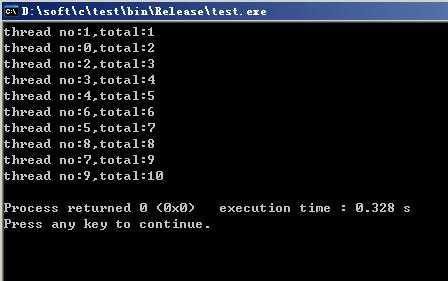标签:
在Java中写多线程相关的程序简单很多,在多线程中需要同步的时候,使用synchronized就行了。
最近学习c的多线程与同步,感觉实现起来,要写的代码比较多一些,这也许是因为java封装的比较好吧。
下面是今天写的一个例子,主要参考:http://hi.baidu.com/personnel/blog/item/ae87720e8b2f5aea7acbe1c6.html
#include <stdio.h> #include <windows.h> #include <process.h> //关键段变量声明 HANDLE g_hThreadEvent; CRITICAL_SECTION g_csThreadCode; int total = 0; //全部变量 unsigned int __stdcall threadFun(void *pm) { int v = *(int *)pm; SetEvent(g_hThreadEvent); //触发事件 Sleep(50); EnterCriticalSection(&g_csThreadCode); //进入子线程互斥区域 total++; printf("thread no:%d,total:%d\n",v,total); LeaveCriticalSection(&g_csThreadCode); //离开子线程互斥区域 return 0; } int main() { //初始化事件和关键段 自动置位,初始无触发的匿名事件 g_hThreadEvent = CreateEvent(NULL, FALSE, FALSE, NULL); //关键段初始化 InitializeCriticalSection(&g_csThreadCode); int i; int THREAD_NUM = 10; //子线程数 HANDLE handle[THREAD_NUM]; for(i=0;i<THREAD_NUM;i++) { handle[i] = _beginthreadex(NULL,0,threadFun,&i,0,NULL); WaitForSingleObject(g_hThreadEvent, INFINITE); //等待事件被触发,这里必须 } WaitForMultipleObjects(THREAD_NUM, handle, TRUE, INFINITE); //用完之后记得销毁 CloseHandle(g_hThreadEvent); DeleteCriticalSection(&g_csThreadCode); return 0; }
运行结果:

这个例子主要测试两点:
1. 主线程与子线程的同步,使用事件(Event),参考:http://blog.csdn.net/morewindows/article/details/7445233
2. 各子线程间的同步,使用关键段(CRITICAL_SECTION),参考:http://blog.csdn.net/morewindows/article/details/7442639
另注:
实现主线程与子线程的同步,有几种方式:事件(Event)、信号量(Semaphore)。
实现子线程的同步,有几种方式,比如:关键段(CRITICAL_SECTION),互斥量(Mutex)。
关于子线程间的两种同步方式的对比,参见:http://hi.baidu.com/personnel/blog/item/fd4a7609ffba398f2fddd436.html
2012-05-13
标签:
原文地址:http://www.cnblogs.com/personnel/p/4583245.html